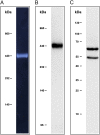Energized outer membrane and spatial separation of metabolic processes in the hyperthermophilic Archaeon Ignicoccus hospitalis
- PMID: 20133662
- PMCID: PMC2840320
- DOI: 10.1073/pnas.0911711107
Energized outer membrane and spatial separation of metabolic processes in the hyperthermophilic Archaeon Ignicoccus hospitalis
Abstract
ATP synthase catalyzes ATP synthesis at the expense of an electrochemical ion gradient across a membrane that can be generated by different exergonic reactions. Sulfur reduction is the main energy-yielding reaction in the hyperthermophilic strictly anaerobic Crenarchaeon Ignicoccus hospitalis. This organism is unusual in having an inner and an outer membrane that are separated by a huge intermembrane compartment. Here we show, on the basis of immuno-EM analyses of ultrathin sections and immunofluorescence experiments with whole I. hospitalis cells, that the ATP synthase and H(2):sulfur oxidoreductase complexes of this organism are located in the outer membrane. These two enzyme complexes are mandatory for the generation of an electrochemical gradient and for ATP synthesis. Thus, among all prokaryotes possessing two membranes in their cell envelope (including Planctomycetes, gram-negative bacteria), I. hospitalis is a unique organism, with an energized outer membrane and ATP synthesis within the periplasmic space. In addition, DAPI staining and EM analyses showed that DNA and ribosomes are localized in the cytoplasm, leading to the conclusion that in I. hospitalis energy conservation is separated from information processing and protein biosynthesis. This raises questions regarding the function of the two membranes, the interaction between these compartments, and the general definition of a cytoplasmic membrane.
Conflict of interest statement
The authors declare no conflict of interest.
Figures




Similar articles
-
The unusual cell biology of the hyperthermophilic Crenarchaeon Ignicoccus hospitalis.Antonie Van Leeuwenhoek. 2012 Aug;102(2):203-19. doi: 10.1007/s10482-012-9748-5. Epub 2012 Jun 1. Antonie Van Leeuwenhoek. 2012. PMID: 22653377 Review.
-
Purification of a Crenarchaeal ATP Synthase in the Light of the Unique Bioenergetics of Ignicoccus Species.J Bacteriol. 2019 Mar 13;201(7):e00510-18. doi: 10.1128/JB.00510-18. Print 2019 Apr 1. J Bacteriol. 2019. PMID: 30642991 Free PMC article.
-
Functional compartmentalization and metabolic separation in a prokaryotic cell.Proc Natl Acad Sci U S A. 2021 Jun 22;118(25):e2022114118. doi: 10.1073/pnas.2022114118. Proc Natl Acad Sci U S A. 2021. PMID: 34161262 Free PMC article.
-
AMP-forming acetyl coenzyme A synthetase in the outermost membrane of the hyperthermophilic crenarchaeon Ignicoccus hospitalis.J Bacteriol. 2012 Mar;194(6):1572-81. doi: 10.1128/JB.06130-11. Epub 2012 Jan 13. J Bacteriol. 2012. PMID: 22247508 Free PMC article.
-
Adaptations of anaerobic archaea to life under extreme energy limitation.FEMS Microbiol Rev. 2014 May;38(3):449-72. doi: 10.1111/1574-6976.12043. Epub 2013 Nov 5. FEMS Microbiol Rev. 2014. PMID: 24118021 Review.
Cited by
-
Spotlight on the Energy Harvest of Electroactive Microorganisms: The Impact of the Applied Anode Potential.Front Microbiol. 2019 Jun 26;10:1352. doi: 10.3389/fmicb.2019.01352. eCollection 2019. Front Microbiol. 2019. PMID: 31293531 Free PMC article.
-
The Iho670 fibers of Ignicoccus hospitalis are anchored in the cell by a spherical structure located beneath the inner membrane.J Bacteriol. 2014 Nov;196(21):3807-15. doi: 10.1128/JB.01861-14. Epub 2014 Aug 25. J Bacteriol. 2014. PMID: 25157085 Free PMC article.
-
Keys to eukaryality: planctomycetes and ancestral evolution of cellular complexity.Front Microbiol. 2012 May 4;3:167. doi: 10.3389/fmicb.2012.00167. eCollection 2012. Front Microbiol. 2012. PMID: 22586422 Free PMC article.
-
Archaea--timeline of the third domain.Nat Rev Microbiol. 2011 Jan;9(1):51-61. doi: 10.1038/nrmicro2482. Epub 2010 Dec 6. Nat Rev Microbiol. 2011. PMID: 21132019 Review.
-
Structural studies of planctomycete Gemmata obscuriglobus support cell compartmentalisation in a bacterium.PLoS One. 2014 Mar 14;9(3):e91344. doi: 10.1371/journal.pone.0091344. eCollection 2014. PLoS One. 2014. PMID: 24632833 Free PMC article.
References
-
- Paper W, et al. Ignicoccus hospitalis sp. nov., the host of ’Nanoarchaeum equitans’. Int J Syst Evol Microbiol. 2007;57:803–808. - PubMed
-
- Huber H, et al. A new phylum of Archaea represented by a nanosized hyperthermophilic symbiont. Nature. 2002;417:63–67. - PubMed
-
- Huber H, et al. Ignicoccus gen. nov., a novel genus of hyperthermophilic, chemolithoautotrophic Archaea, represented by two new species, Ignicoccus islandicus sp. nov. and Ignicoccus pacificus sp. nov. Int J Syst Evol Microbiol. 2000;50:2093–2100. - PubMed
Publication types
MeSH terms
Substances
LinkOut - more resources
Full Text Sources
Other Literature Sources
Molecular Biology Databases

